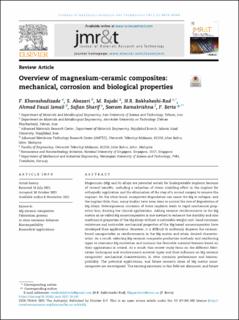| dc.contributor.author | Khorashadizade, F. | |
| dc.contributor.author | Abazari, S. | |
| dc.contributor.author | Rajabi, M. | |
| dc.contributor.author | Bakhsheshi-Rad, Hamid Reza | |
| dc.contributor.author | Ismail, Ahmad Fauzi | |
| dc.contributor.author | Sharif, Safian | |
| dc.contributor.author | Ramakrishna, Seeram | |
| dc.contributor.author | Berto, Filippo | |
| dc.date.accessioned | 2023-01-16T10:20:01Z | |
| dc.date.available | 2023-01-16T10:20:01Z | |
| dc.date.created | 2022-01-13T11:34:47Z | |
| dc.date.issued | 2021 | |
| dc.identifier.citation | Journal of Materials Research and Technology (JMR&T). 2021, 15 6034-6066. | en_US |
| dc.identifier.issn | 2238-7854 | |
| dc.identifier.uri | https://hdl.handle.net/11250/3043646 | |
| dc.description.abstract | Magnesium (Mg) and its alloys are potential metals for biodegradable implants because of several benefits, including a reduction of stress shielding effect in the implant for orthopedic application and the elimination of the step of a second surgery to remove the implant. On the other hand, unexpected degradation can cause the Mg to collapse, and the implant fails; thus, many studies have been done to control the rate of degradation of Mg alloys. Heterogeneous corrosion of these implants leads to rapid mechanical properties loss, limiting the clinical applications. Adding ceramic reinforcements to the Mg matrix as so-called Mg nanocomposites is one method to enhance the ductility and also mechanical properties of the Mg alloys without a noticeable weight cost. Good corrosion resistance and noticeable mechanical properties of the Mg-based nanocomposites have developed their applications. However, it is difficult to uniformly disperse the ceramic-based nanoparticles as reinforcements in the Mg matrix and attain desired characteristics. As a result, selecting Mg-ceramic composite production methods and reinforcing types to overcome Mg restriction and increase the favorable material features based on their applications is critical. As a result, this review study focus on the different fabrication techniques and reinforcement material types and their influence on Mg-ceramic composites’ mechanical characteristics, in vitro corrosion performance and biocompatibility. The potential applications, and future research ideas of Mg matrix nanocomposite are investigated. The existing successes in this field are discussed, and future investigation areas are identified in order to boost the usage of degradable Mg-based composites. | en_US |
| dc.language.iso | eng | en_US |
| dc.publisher | Elsevier | en_US |
| dc.rights | Attribution-NonCommercial-NoDerivatives 4.0 Internasjonal | * |
| dc.rights.uri | http://creativecommons.org/licenses/by-nc-nd/4.0/deed.no | * |
| dc.title | Overview of magnesium-ceramic composites: mechanical, corrosion and biological properties | en_US |
| dc.title.alternative | Overview of magnesium-ceramic composites: mechanical, corrosion and biological properties | en_US |
| dc.type | Peer reviewed | en_US |
| dc.type | Journal article | en_US |
| dc.description.version | publishedVersion | en_US |
| dc.source.pagenumber | 6034-6066 | en_US |
| dc.source.volume | 15 | en_US |
| dc.source.journal | Journal of Materials Research and Technology (JMR&T) | en_US |
| dc.identifier.doi | 10.1016/j.jmrt.2021.10.141 | |
| dc.identifier.cristin | 1980287 | |
| cristin.ispublished | true | |
| cristin.fulltext | original | |
| cristin.qualitycode | 1 | |

